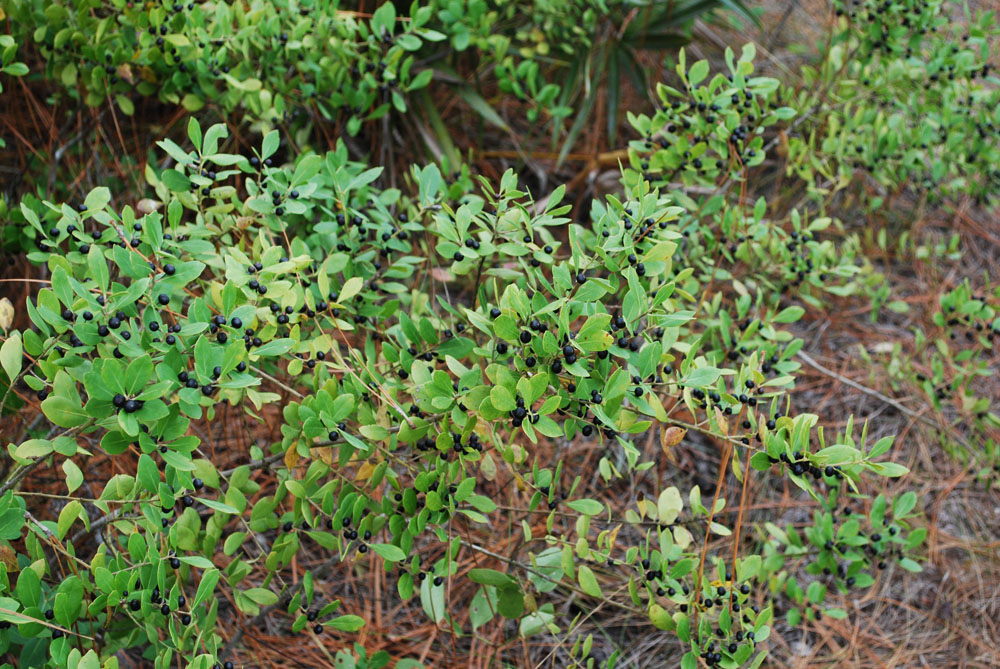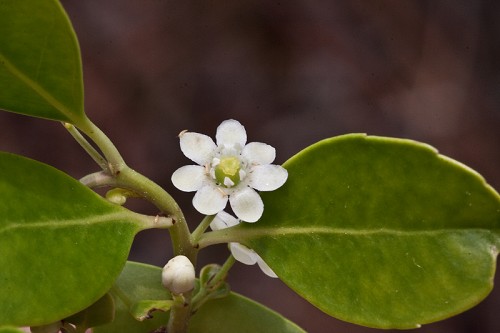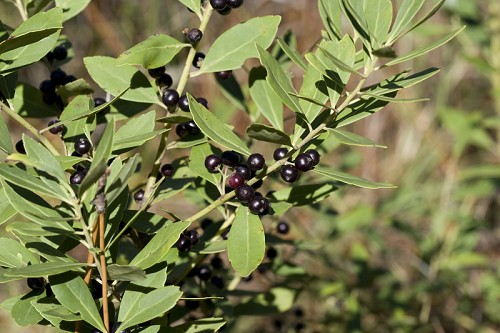Difference between revisions of "Ilex glabra"
(→Photo Gallery) |
Krobertson (talk | contribs) |
||
| Line 22: | Line 22: | ||
==Description== | ==Description== | ||
<!-- Basic life history facts such as annual/perrenial, monoecious/dioecious, root morphology, seed type, etc. --> | <!-- Basic life history facts such as annual/perrenial, monoecious/dioecious, root morphology, seed type, etc. --> | ||
| − | “Trees or shrubs, usually with imperfect flowers. Leaves simple, entire, serrate, dentate or crenate; stipules obsolete. Flowers axillary, solitary, fascicled or in cymes, 4-7 merous, 4-8 mm broad; petals united at the base, imbricate in bud; pistillate flowers usually with nonfunctional stamens; anthers opening lengthwise; stigmas 4-7, essentially sessile. Drupe red, black or rarely yellow or white. Seeds with hard, bony endocarp (pyrenes), often grooved or ribbed on the back, 4-7 in a fruit, 1 in each locule.” | + | “Trees or shrubs, usually with imperfect flowers. Leaves simple, entire, serrate, dentate or crenate; stipules obsolete. Flowers axillary, solitary, fascicled or in cymes, 4-7 merous, 4-8 mm broad; petals united at the base, imbricate in bud; pistillate flowers usually with nonfunctional stamens; anthers opening lengthwise; stigmas 4-7, essentially sessile. Drupe red, black or rarely yellow or white. Seeds with hard, bony endocarp (pyrenes), often grooved or ribbed on the back, 4-7 in a fruit, 1 in each locule.” <ref name="Radford et al 1964">Radford, Albert E., Harry E. Ahles, and C. Ritchie Bell. Manual of the Vascular Flora of the Carolinas. 1964, 1968. The University of North Carolina Press. 679-84. Print.</ref> |
| − | "Rhizomatous shrub to 3m tall, usually forming extensive colonies, twigs puberulent. Leaves evergreen, obovate to elliptic, 2.5-6.5 cm long, crenate, but usually only toward the apex, the last pair of teeth usually directly opposite each other, glabrous, lustrous above; petioles 38 mm long, canescent. Pedicels 1-5 mm long, appearing longer when single fruited (careful examination shows that the lower part is peduncle). Staminate flowers in axillary, 3-7 flowered, pedunculate cymes. Pistillate flowers axillary, solitary or in 3-flowered, pedunculate cymes. Flowers 5-7 merous. Drupe black, dull or slightly lustrous, globose, 5-7 in diam.; pyrenes 5-7, smooth, 3-4 mm long." | + | "Rhizomatous shrub to 3m tall, usually forming extensive colonies, twigs puberulent. Leaves evergreen, obovate to elliptic, 2.5-6.5 cm long, crenate, but usually only toward the apex, the last pair of teeth usually directly opposite each other, glabrous, lustrous above; petioles 38 mm long, canescent. Pedicels 1-5 mm long, appearing longer when single fruited (careful examination shows that the lower part is peduncle). Staminate flowers in axillary, 3-7 flowered, pedunculate cymes. Pistillate flowers axillary, solitary or in 3-flowered, pedunculate cymes. Flowers 5-7 merous. Drupe black, dull or slightly lustrous, globose, 5-7 in diam.; pyrenes 5-7, smooth, 3-4 mm long." <ref name="Radford et al 1964"/> |
==Distribution== | ==Distribution== | ||
==Ecology== | ==Ecology== | ||
===Habitat=== <!--Natural communities, human disturbed habitats, topography, hydrology, soils, light, fire regime requirements for removal of competition, etc.--> | ===Habitat=== <!--Natural communities, human disturbed habitats, topography, hydrology, soils, light, fire regime requirements for removal of competition, etc.--> | ||
| − | ''Ilex glabra'' is restricted to native groundcover with a statistical affinity in upland pinelands of South Georgia | + | ''Ilex glabra'' is restricted to native groundcover with a statistical affinity in upland pinelands of South Georgia. <ref name="Ostertag and Robertson 2007">Ostertag, T.E., and K.M. Robertson. 2007. A comparison of native versus old-field vegetation in upland pinelands managed with frequent fire, South Georgia, USA. Pages 109–120 in R.E. Masters and K.E.M. Galley (eds.). Proceedings of the 23rd Tall Timbers Fire Ecology Conference: Fire in Grassland and Shrubland Ecosystems.</ref> |
<!--===Phenology===--> <!--Timing off flowering, fruiting, seed dispersal, and environmental triggers. Cite PanFlora website if appropriate: http://www.gilnelson.com/PanFlora/ --> | <!--===Phenology===--> <!--Timing off flowering, fruiting, seed dispersal, and environmental triggers. Cite PanFlora website if appropriate: http://www.gilnelson.com/PanFlora/ --> | ||
| Line 68: | Line 68: | ||
==References and notes== | ==References and notes== | ||
Deyrup, M.A. and N.D. 2015. Database of observations of Hymenoptera visitations to flowers of plants on Archbold Biological Station, Florida, USA. | Deyrup, M.A. and N.D. 2015. Database of observations of Hymenoptera visitations to flowers of plants on Archbold Biological Station, Florida, USA. | ||
| − | |||
| − | |||
| − | |||
| − | |||
Revision as of 15:32, 29 July 2016
| Ilex glabra | |
|---|---|

| |
| Photo by Wayne Matchett, SpaceCoastWildflowers.com | |
| Scientific classification | |
| Kingdom: | Plantae |
| Division: | Magnoliophyta - Flowering plants |
| Class: | Magnoliopsida - Dicotyledons |
| Order: | Celastrales |
| Family: | Aquifoliaceae |
| Genus: | Ilex |
| Species: | I. glabra |
| Binomial name | |
| Ilex glabra (L.) A. Gray | |

| |
| Natural range of Ilex glabra from USDA NRCS Plants Database. | |
Common name: Inkberry
Contents
Taxonomic notes
Description
“Trees or shrubs, usually with imperfect flowers. Leaves simple, entire, serrate, dentate or crenate; stipules obsolete. Flowers axillary, solitary, fascicled or in cymes, 4-7 merous, 4-8 mm broad; petals united at the base, imbricate in bud; pistillate flowers usually with nonfunctional stamens; anthers opening lengthwise; stigmas 4-7, essentially sessile. Drupe red, black or rarely yellow or white. Seeds with hard, bony endocarp (pyrenes), often grooved or ribbed on the back, 4-7 in a fruit, 1 in each locule.” [1]
"Rhizomatous shrub to 3m tall, usually forming extensive colonies, twigs puberulent. Leaves evergreen, obovate to elliptic, 2.5-6.5 cm long, crenate, but usually only toward the apex, the last pair of teeth usually directly opposite each other, glabrous, lustrous above; petioles 38 mm long, canescent. Pedicels 1-5 mm long, appearing longer when single fruited (careful examination shows that the lower part is peduncle). Staminate flowers in axillary, 3-7 flowered, pedunculate cymes. Pistillate flowers axillary, solitary or in 3-flowered, pedunculate cymes. Flowers 5-7 merous. Drupe black, dull or slightly lustrous, globose, 5-7 in diam.; pyrenes 5-7, smooth, 3-4 mm long." [1]
Distribution
Ecology
Habitat
Ilex glabra is restricted to native groundcover with a statistical affinity in upland pinelands of South Georgia. [2]
Pollination
The following Hymenoptera families and species were observed visiting flowers of Ilex glabra at Archbold Biological Station (Deyrup 2015):
Apidae: Apis mellifera, Bombus griseocollis, B. impatiens, Epeolus erigeronis, E. glabratus, E. pusillus, E. zonatus
Colletidae: Colletes banksi, C. brimleyi, C. distinctus, C. mandibularis, C. nudus, C. sp. A., C. thysanellae, Hylaeus confluens, H. schwarzi
Halictidae: Agapostemon splendens, Augochlora pura, Augochloropsis metallica, Halictus poeyi, Lasioglossum coreopsis, L. miniatulus, L. nymphalis, L. pectoralis, L. placidensis, L. puteulanum, Sphecodes brachycephalus
Leucospididae: Leucospis affinis, L. slossonae
Megachilidae: Anthidiellum notatum rufomaculatum, A. perplexum, Anthidium maculifrons, Coelioxys sayi, Dianthidium floridiense, Megachile brevis pseudobrevis, M. exilis parexilis, M. mendica, M. petulans, M. rugifrons, M. xylocopoides
Pompilidae: Ageniella partita, Anoplius krombeini, Episyron conterminus posterus, Priocnemis cornica, Psorthaspis legata, Sericopompilus apicalis
Sphecidae: Alysson melleus, Bembecinus nanus floridanus, Bembix sayi, Bicyrtes quadrifasciata, Cerceris bicornuta, C. blakei, C. flavofasciata floridensis, C. fumipennis, C. rufopicta, Crabro arcadiensis, Ectemnius rufipes ais, Gorytes dorothyae ruseolus, Isodontia auripes, I. exornata, I. mexicana, Larropsis greeni, Liris muesebecki, Microbembex monodonta, Miscophus americanum, M. slossonae slossonae, Oxybelus laetus fulvipes, Palmodes dimidiatus, Sphex ichneumoneus, Stictiella serrata, Tachysphex apicalis, T. similis, Tanyoprymnus moneduloides, Trypargilum clavatum johannis, T. collinum
Vespidae: Eumenes fraternus, E. smithii, Leptochilus alcolhuus, L. krombeini, L. republicanus, Mischocyttarus cubensis, Monobia quadridens, Pachodynerus erynnis, Parancistrocerus fulvipes rufovestris, P. salcularis rufulus, Polistes dorsalis hunteri, Stenodynerus fundatiformis, S. lineatifrons, Vespula squamosa, Zethus slossonae, Z. spinipes
Conservation and management
Cultivation and restoration
Photo Gallery
Flower of Ilex glabra Photo by John R. Gwaltney
Fruit of Ilex glabra Photo by John R. Gwaltney
References and notes
Deyrup, M.A. and N.D. 2015. Database of observations of Hymenoptera visitations to flowers of plants on Archbold Biological Station, Florida, USA.
- ↑ 1.0 1.1 Radford, Albert E., Harry E. Ahles, and C. Ritchie Bell. Manual of the Vascular Flora of the Carolinas. 1964, 1968. The University of North Carolina Press. 679-84. Print.
- ↑ Ostertag, T.E., and K.M. Robertson. 2007. A comparison of native versus old-field vegetation in upland pinelands managed with frequent fire, South Georgia, USA. Pages 109–120 in R.E. Masters and K.E.M. Galley (eds.). Proceedings of the 23rd Tall Timbers Fire Ecology Conference: Fire in Grassland and Shrubland Ecosystems.

